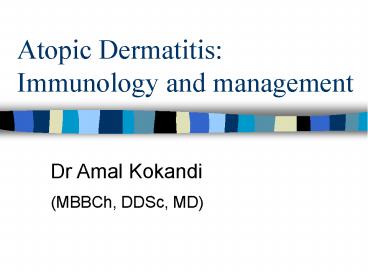Atopic Dermatitis: Immunology and management - PowerPoint PPT Presentation
Title:
Atopic Dermatitis: Immunology and management
Description:
Title: Dermatology in General Practice Author: Tim Rees Last modified by: akokandi Created Date: 10/21/2004 8:35:58 PM Document presentation format – PowerPoint PPT presentation
Number of Views:330
Avg rating:3.0/5.0
Title: Atopic Dermatitis: Immunology and management
1
Atopic Dermatitis Immunology and management
- Dr Amal Kokandi
- (MBBCh, DDSc, MD)
2
ECZEMA
- Synonymous with dermatitis
- Large proportion of skin disease in developed
world - 10 of population at any one time
- 40 of population at some time
3
Features of eczema
- Itchy
- Erythematous
- Dry
- Flaky
- Oedematous
- Crusted
- Vesicles
- lichenified
4
Diagnosis
- Clinical
- No specific laboratory test
- Family history of atopy is helpful
- Criteria for research studies Hanifin Rajka
(1980), United Kingdom Party Criteria (1994)
5
Severity
- Clinical Extent, sleep disturbance, Itching,
Quality of life. - ADASI (diagramatic), SASSAD, SIS (intensity
scoring), etc - Biophysical methods
- Eosinophils
- IgE (80)
- Immunological markers (sIL-2R, ECP, sCD23,
sICAM-1, sELAM-1, sVCAM-1, E selectin, MBP..)
6
Atopic eczema
- Endogenous
- Atopic i.e asthma, hay fever
- 5 of population
- 10-15 of all children affected at some time
7
Exacerbating factors
- Detergents
- Infection
- Teething
- Stress
- Cat and dog fur
- ???? House dust mite
- ???? Food allergen
8
Clinical features
- Itchy erythematous scaly patches
- Flexures of knees and elbows
- Neck
- Face in infants
- Exaggerated skin markings
- Lichenification
- Nail pitted ridged
9
(No Transcript)
10
(No Transcript)
11
(No Transcript)
12
(No Transcript)
13
(No Transcript)
14
complications
- Bacterial infection
- Viral infections warts, molluscum, herpes
- Keratoconjunctivitis
- Retarded growth
15
Pathogenesis
- Not fully understood
- Genetics
- Environmental factors Irritants, aeroallergens,
seasonal, hormonal and stress - Microbial organisms (Staph Aureus, Malassezia,
skin fungi.) and superantigens - Modified skin barrier function
- Deficiency in innate immune system and toll like
receptors - Specific immunity (biphasic Th1 Th2)
16
Genetics of atopic eczema
- 77 15 concordance in mono- dizygotic twins.
- significant linkage on chromosomes 1q21, 3q21 ,
3q24-22 , 3p26-24 17q25 - polymorphisms in genes important for epidermal
differentiation, inflammation (IL-4, IL-12,
Fillagrin.)
17
investigations
- Clinical
- ??IgE
- ??RAST
18
Prognosis
- Most grow out of it!
- 15 may come back often very mildly
19
Treatment
- Patient education
- Emollients
- Avoid triggering factors irritants especially
soap - Topical steroids
- Treat infections
- Sedating antihistamines
- Second line agents Calcineurin inhibitors, UV
therapy and systemic therapy - Immunotherapy Desensitization
20
creams
- Cosmetically more acceptable
- Water based
- Contain preservatives
- Soap substitutes
21
ointments
- Oil based
- Dont contain preservative
- Feel greasy
- Good for hydrating
22
Topical steroids potency (European)
- Mild hydrocortisone
- Moderate eumovate
- Potent betnovate
- Very potent dermovate
23
Topical steroid potency (American)
- Class1 (superpotent)
- Class2 (potent)
- Class3 (potent)
- Class4 (midstrength)
- Class5 (midstrength)
- Class6 (mild)
- Class7 (least potent)
24
FTU
- Finger tip unit
- Helps to give estimation of topical steroid
amount used - To avoid over and under use of steroid
25
FTU
26
Finger tip unit
- 2 FTU nearly 1 gram
- Enough for twice size of adult hand
- A hand and fingers (front and back) 1FTU
- A foot (all over) 2FTU
- Front of chest and abdomen 7FTU
- Back and buttocks 7FTU
- Face and neck 2.5 FTU
- An entire arm and hand 4 FTU
- An entire leg and foot 8 FTU
27
Special considerations
- Face
- Intertriginous areas
- Children
- Effect of occlusion
- infections and combination formulas (with
antibiotics and antifungals)
28
Topical steroid side effects
- Perioral dermatitis and rosacea
- Tachyphylaxis steroid addiction
- Infections (tinea incognito, herpes simplex,
pityriasis versicolor, scabies) - Adrenal suppression
- Glucoma and cataract
- Angina bullosa purpura (hard palate)
29
Topical steroid side effects
- Telangiectasia, purpura, epidermal, dermal and
subcutaneous atrophy, striae, psuedoscars - Folliculitis
- Allergic reactions
- Hypopigmentation
- Hypertrichosis
- Delayed wound healing
- Alteration in skin elasticity mechanical
properties - tinea incognito
30
(No Transcript)































